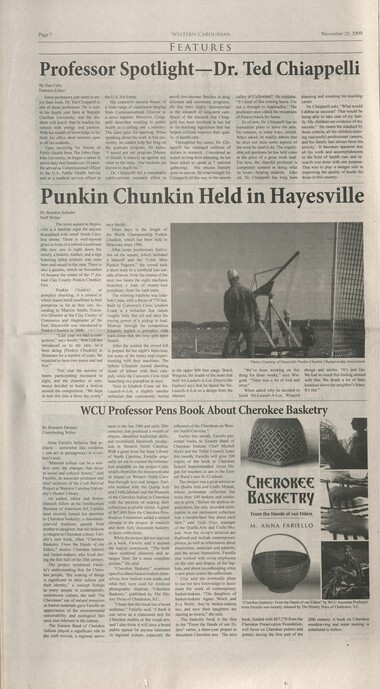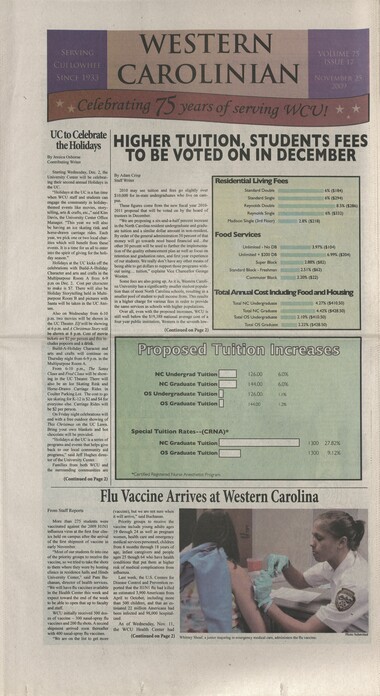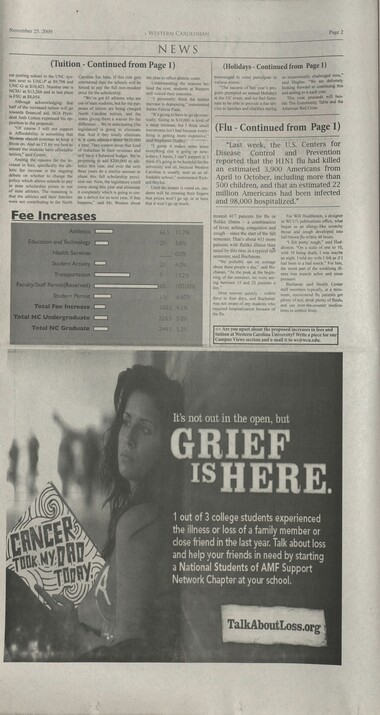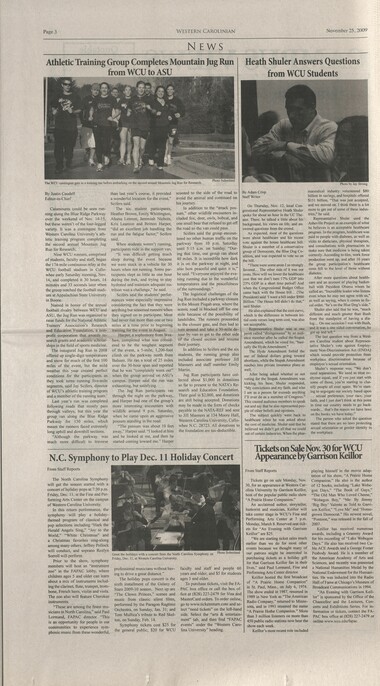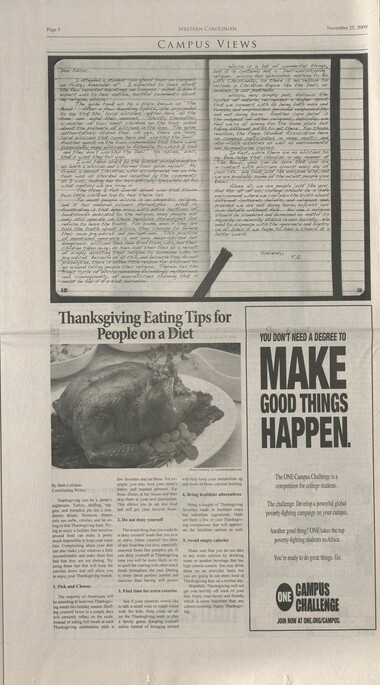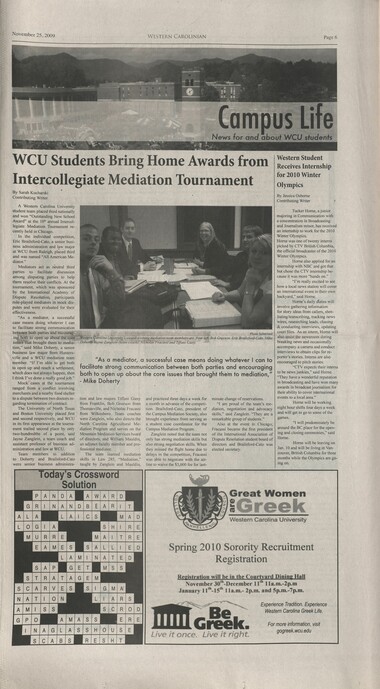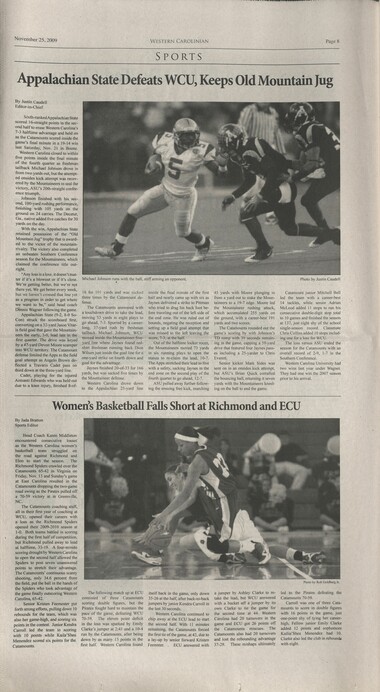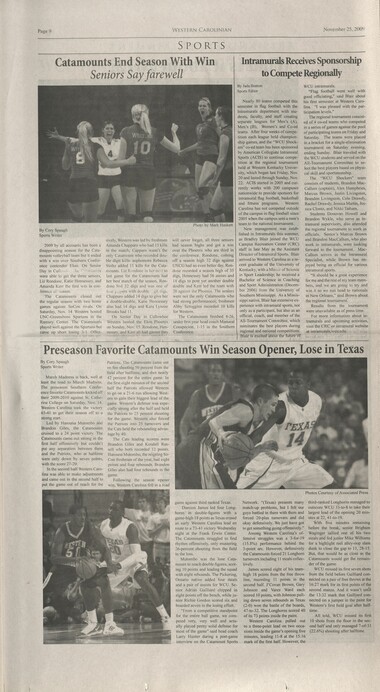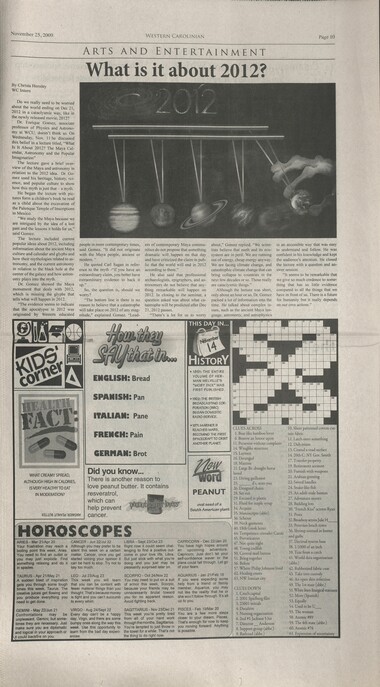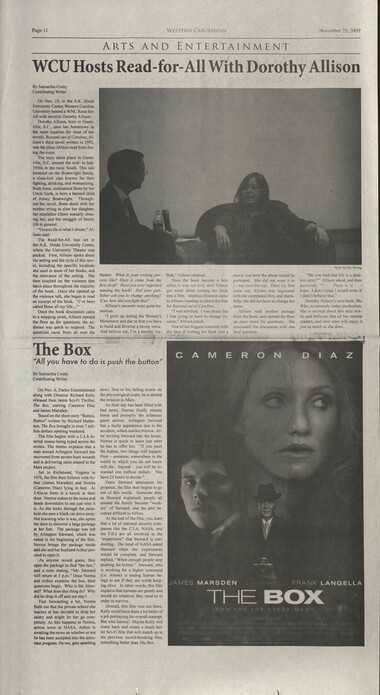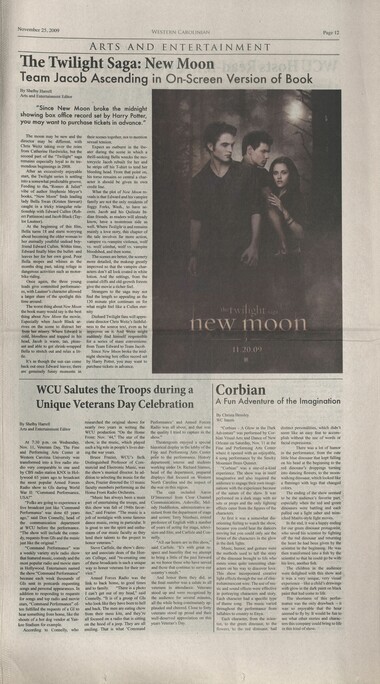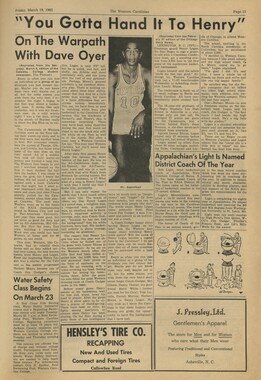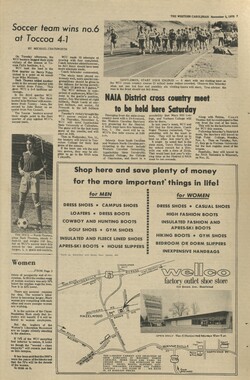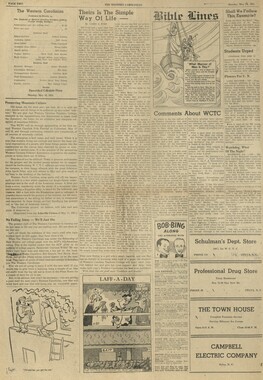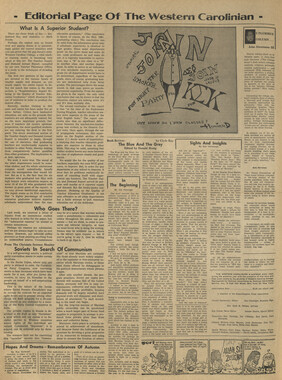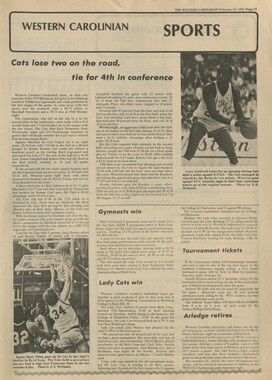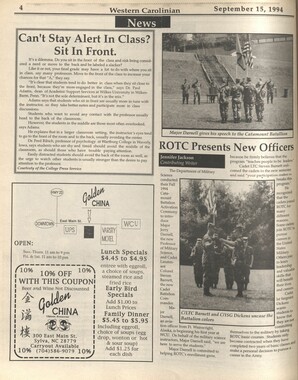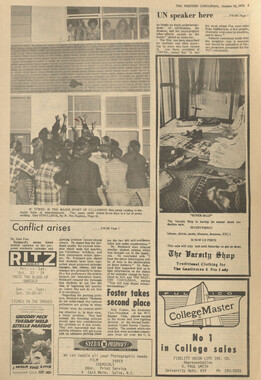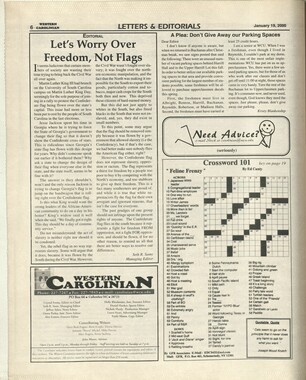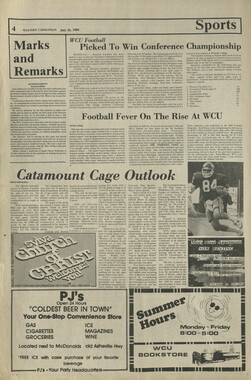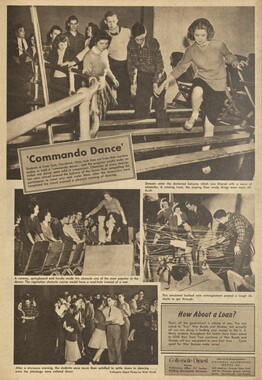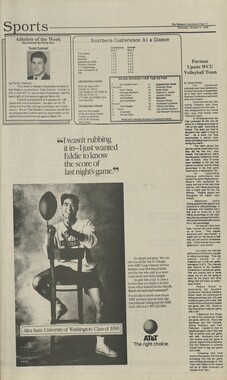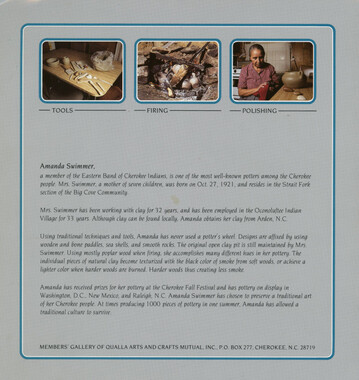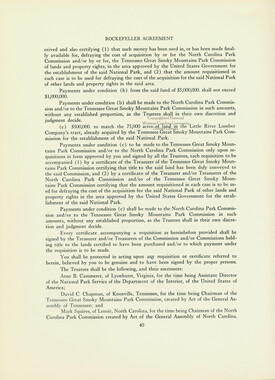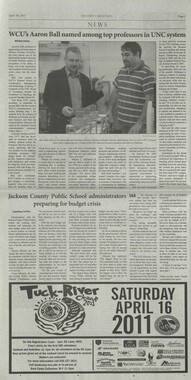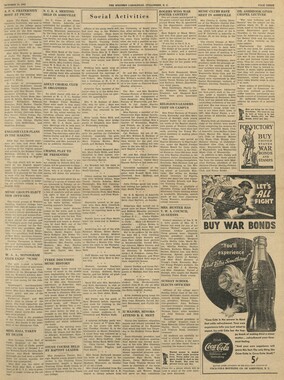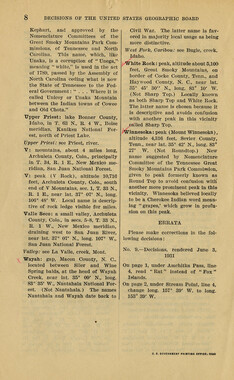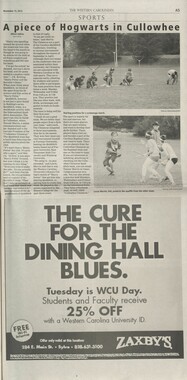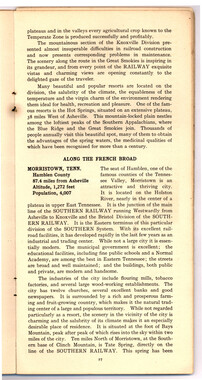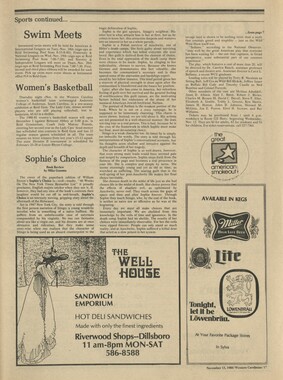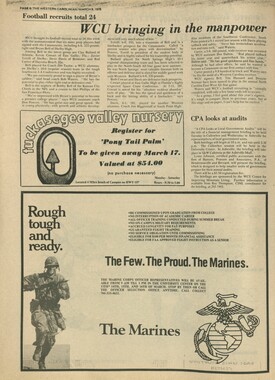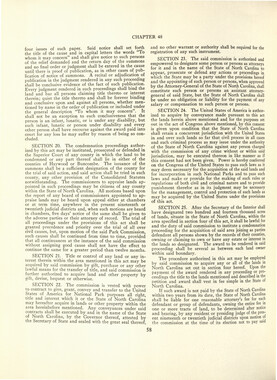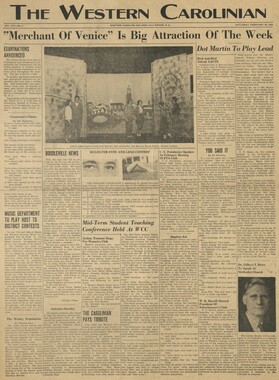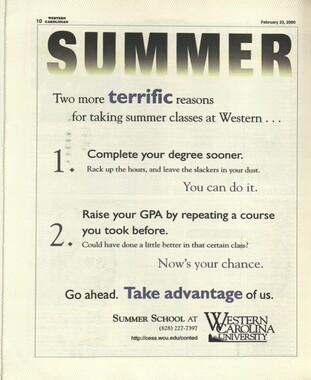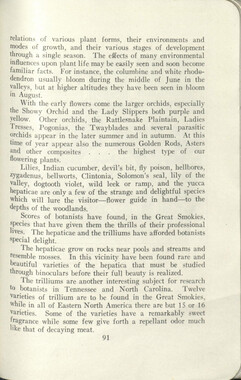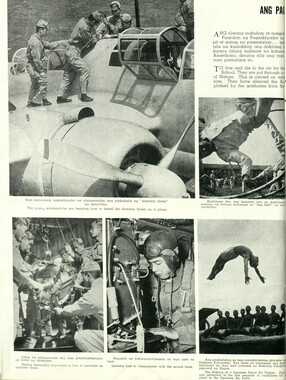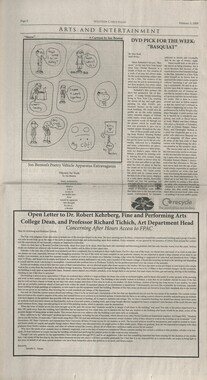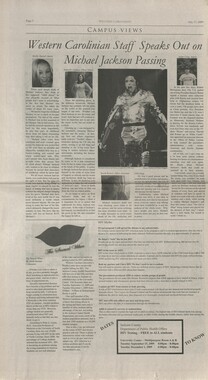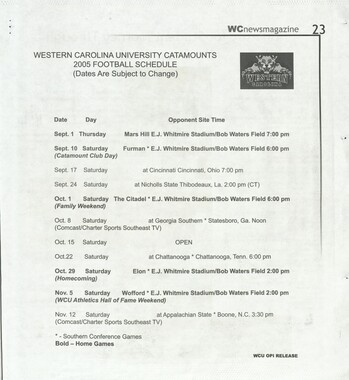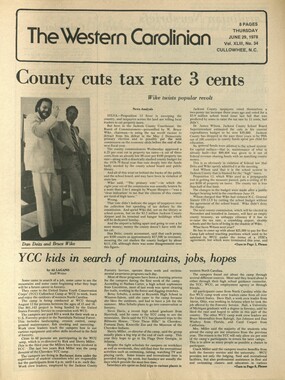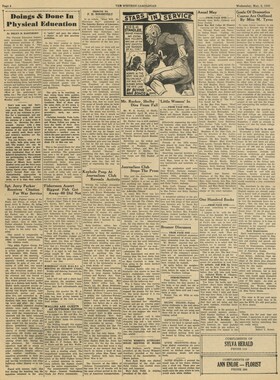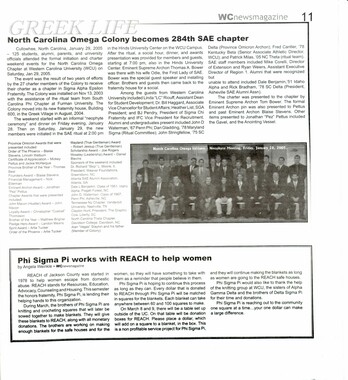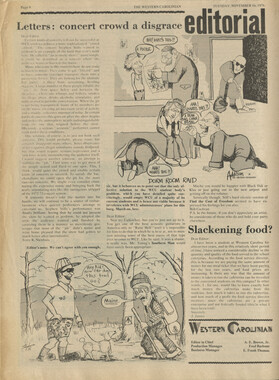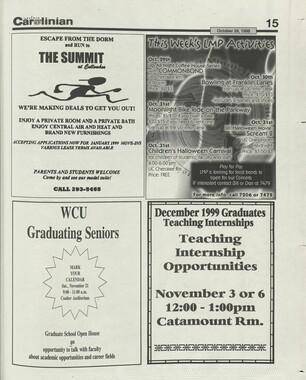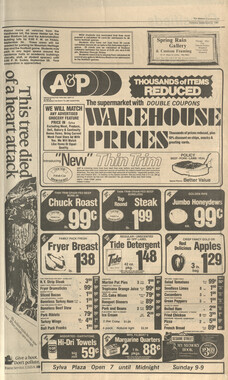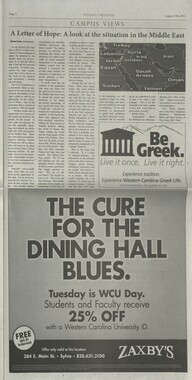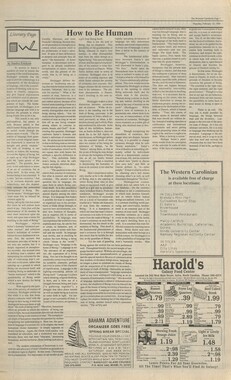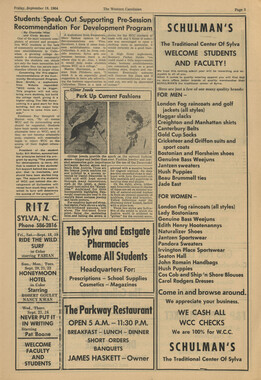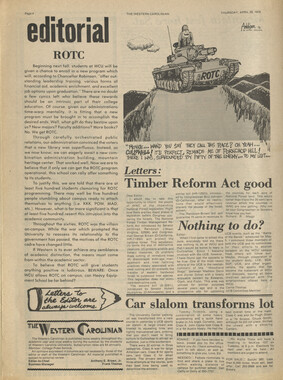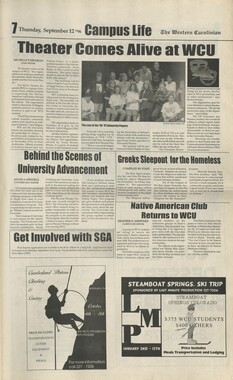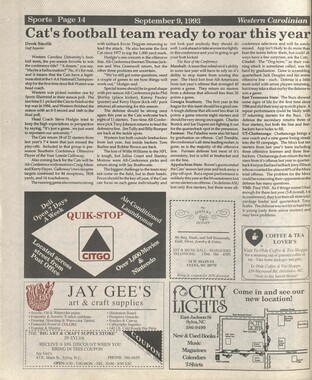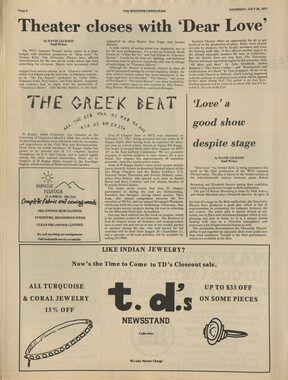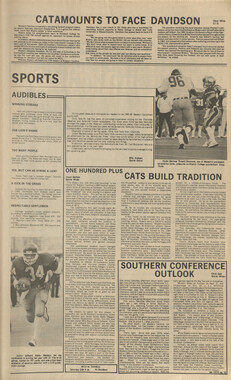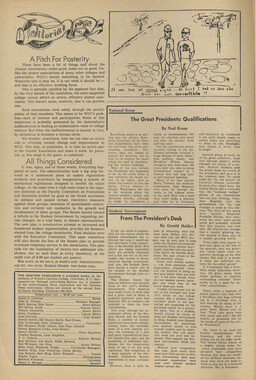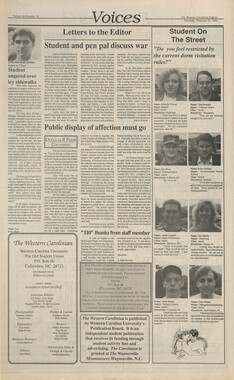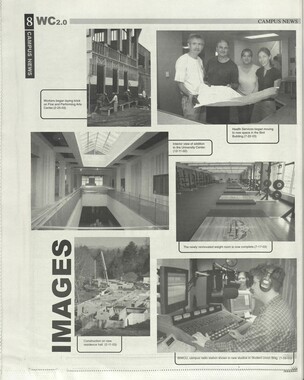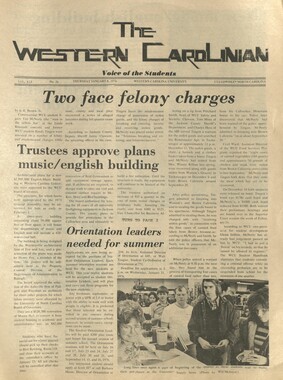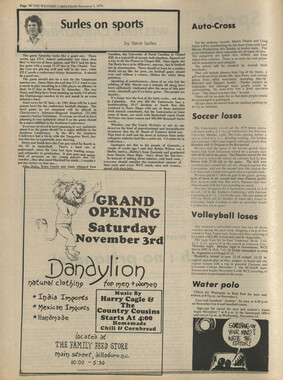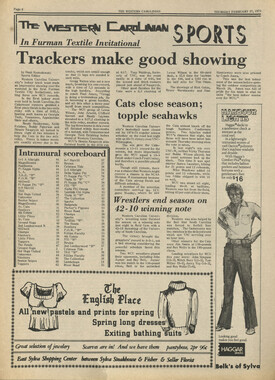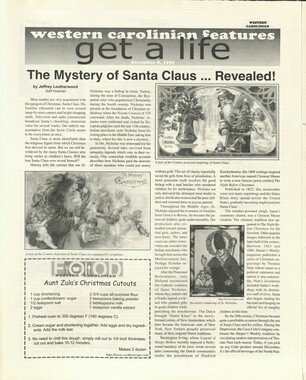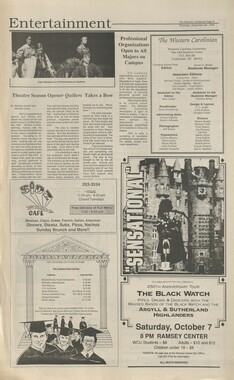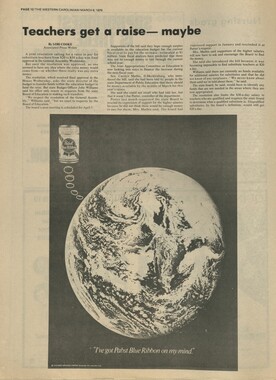Western Carolina University (21)
View all
- Canton Champion Fibre Company (2308)
- Cherokee Traditions (291)
- Civil War in Southern Appalachia (165)
- Craft Revival (1942)
- George Masa Collection (135)
- Great Smoky Mountains - A Park for America (2901)
- Highlights from Western Carolina University (422)
- Horace Kephart (941)
- Journeys Through Jackson (159)
- LGBTQIA+ Archive of Jackson County (85)
- Oral Histories of Western North Carolina (314)
- Picturing Appalachia (6798)
- Stories of Mountain Folk (413)
- Travel Western North Carolina (153)
- Western Carolina University Fine Art Museum Vitreograph Collection (129)
- Western Carolina University Herbarium (92)
- Western Carolina University: Making Memories (738)
- Western Carolina University Publications (2491)
- Western Carolina University Restricted Electronic Theses and Dissertations (146)
- Western North Carolina Regional Maps (71)
- World War II in Southern Appalachia (131)
University of North Carolina Asheville (6)
View all
- Allanstand Cottage Industries (62)
- Appalachian National Park Association (53)
- Bennett, Kelly, 1890-1974 (1463)
- Berry, Walter (76)
- Brasstown Carvers (40)
- Carver, George Washington, 1864?-1943 (26)
- Cathey, Joseph, 1803-1874 (1)
- Champion Fibre Company (233)
- Champion Paper and Fibre Company (297)
- Cherokee Indian Fair Association (16)
- Cherokee Language Program (22)
- Crowe, Amanda (40)
- Edmonston, Thomas Benton, 1842-1907 (7)
- Ensley, A. L. (Abraham Lincoln), 1865-1948 (275)
- Fromer, Irving Rhodes, 1913-1994 (70)
- George Butz (BFS 1907) (46)
- Goodrich, Frances Louisa (120)
- Grant, George Alexander, 1891-1964 (96)
- Heard, Marian Gladys (60)
- Kephart, Calvin, 1883-1969 (15)
- Kephart, Horace, 1862-1931 (313)
- Kephart, Laura, 1862-1954 (39)
- Laney, Gideon Thomas, 1889-1976 (439)
- Masa, George, 1881-1933 (61)
- McElhinney, William Julian, 1896-1953 (44)
- Niggli, Josephina, 1910-1983 (10)
- North Carolina Park Commission (105)
- Osborne, Kezia Stradley (9)
- Owens, Samuel Robert, 1918-1995 (11)
- Penland Weavers and Potters (36)
- Roberts, Vivienne (15)
- Roth, Albert, 1890-1974 (142)
- Schenck, Carl Alwin, 1868-1955 (1)
- Sherrill's Photography Studio (2565)
- Southern Highland Handicraft Guild (127)
- Southern Highlanders, Inc. (71)
- Stalcup, Jesse Bryson (46)
- Stearns, I. K. (213)
- Thompson, James Edward, 1880-1976 (226)
- United States. Indian Arts and Crafts Board (130)
- USFS (683)
- Vance, Zebulon Baird, 1830-1894 (1)
- Weaver, Zebulon, 1872-1948 (58)
- Western Carolina College (230)
- Western Carolina Teachers College (282)
- Western Carolina University (2008)
- Western Carolina University. Mountain Heritage Center (18)
- Whitman, Walt, 1819-1892 (10)
- Wilburn, Hiram Coleman, 1880-1967 (73)
- Williams, Isadora (3)
- Cain, Doreyl Ammons (0)
- Crittenden, Lorraine (0)
- Rhodes, Judy (0)
- Smith, Edward Clark (0)
- Appalachian Region, Southern (2924)
- Asheville (N.C.) (1941)
- Avery County (N.C.) (26)
- Blount County (Tenn.) (195)
- Buncombe County (N.C.) (1672)
- Cherokee County (N.C.) (283)
- Clay County (N.C.) (556)
- Graham County (N.C.) (236)
- Great Smoky Mountains National Park (N.C. and Tenn.) (525)
- Haywood County (N.C.) (3569)
- Henderson County (N.C.) (70)
- Jackson County (N.C.) (4913)
- Knox County (Tenn.) (35)
- Knoxville (Tenn.) (13)
- Lake Santeetlah (N.C.) (10)
- Macon County (N.C.) (420)
- Madison County (N.C.) (215)
- McDowell County (N.C.) (39)
- Mitchell County (N.C.) (135)
- Polk County (N.C.) (35)
- Qualla Boundary (982)
- Rutherford County (N.C.) (76)
- Swain County (N.C.) (2182)
- Transylvania County (N.C.) (270)
- Watauga County (N.C.) (12)
- Waynesville (N.C.) (86)
- Yancey County (N.C.) (72)
- Aerial Photographs (3)
- Aerial Views (60)
- Albums (books) (4)
- Articles (1)
- Artifacts (object Genre) (228)
- Bibliographies (1)
- Biography (general Genre) (2)
- Cards (information Artifacts) (38)
- Clippings (information Artifacts) (191)
- Copybooks (instructional Materials) (3)
- Crafts (art Genres) (622)
- Depictions (visual Works) (21)
- Design Drawings (1)
- Drawings (visual Works) (185)
- Envelopes (73)
- Exhibitions (events) (1)
- Facsimiles (reproductions) (1)
- Fiction (general Genre) (4)
- Financial Records (12)
- Fliers (printed Matter) (67)
- Glass Plate Negatives (381)
- Guidebooks (2)
- Internegatives (10)
- Interviews (815)
- Land Surveys (102)
- Letters (correspondence) (1013)
- Manuscripts (documents) (618)
- Maps (documents) (177)
- Memorandums (25)
- Minutes (administrative Records) (59)
- Negatives (photographs) (6090)
- Newsletters (1290)
- Newspapers (2)
- Notebooks (8)
- Occupation Currency (1)
- Paintings (visual Works) (1)
- Pen And Ink Drawings (1)
- Periodicals (193)
- Personal Narratives (10)
- Photographs (12976)
- Plans (maps) (1)
- Poetry (5)
- Portraits (4568)
- Postcards (329)
- Programs (documents) (181)
- Publications (documents) (2443)
- Questionnaires (65)
- Relief Prints (26)
- Sayings (literary Genre) (1)
- Scrapbooks (282)
- Sheet Music (2)
- Slides (photographs) (402)
- Songs (musical Compositions) (2)
- Sound Recordings (796)
- Specimens (92)
- Speeches (documents) (18)
- Tintypes (photographs) (8)
- Transcripts (322)
- Video Recordings (physical Artifacts) (23)
- Text Messages (0)
- A.L. Ensley Collection (275)
- Appalachian Industrial School Records (7)
- Appalachian National Park Association Records (336)
- Axley-Meroney Collection (2)
- Bayard Wootten Photograph Collection (20)
- Bethel Rural Community Organization Collection (7)
- Blumer Collection (5)
- C.W. Slagle Collection (20)
- Canton Area Historical Museum (2110)
- Carlos C. Campbell Collection (462)
- Cataloochee History Project (64)
- Cherokee Studies Collection (4)
- Daisy Dame Photograph Album (5)
- Daniel Boone VI Collection (1)
- Doris Ulmann Photograph Collection (112)
- Elizabeth H. Lasley Collection (1)
- Elizabeth Woolworth Szold Fleharty Collection (4)
- Frank Fry Collection (95)
- George Masa Collection (173)
- Gideon Laney Collection (452)
- Hazel Scarborough Collection (2)
- Hiram C. Wilburn Papers (28)
- Historic Photographs Collection (236)
- Horace Kephart Collection (861)
- Humbard Collection (33)
- Hunter and Weaver Families Collection (1)
- I. D. Blumenthal Collection (4)
- Isadora Williams Collection (4)
- Jesse Bryson Stalcup Collection (47)
- Jim Thompson Collection (224)
- John B. Battle Collection (7)
- John C. Campbell Folk School Records (80)
- John Parris Collection (6)
- Judaculla Rock project (2)
- Kelly Bennett Collection (1482)
- Love Family Papers (11)
- Major Wiley Parris Civil War Letters (3)
- Map Collection (12)
- McFee-Misemer Civil War Letters (34)
- Mountain Heritage Center Collection (4)
- Norburn - Robertson - Thomson Families Collection (44)
- Pauline Hood Collection (7)
- Pre-Guild Collection (2)
- Qualla Arts and Crafts Mutual Collection (12)
- R.A. Romanes Collection (681)
- Rosser H. Taylor Collection (1)
- Samuel Robert Owens Collection (94)
- Sara Madison Collection (144)
- Sherrill Studio Photo Collection (2558)
- Smoky Mountains Hiking Club Collection (616)
- Stories of Mountain Folk - Radio Programs (374)
- The Reporter, Western Carolina University (510)
- Venoy and Elizabeth Reed Collection (16)
- WCU Gender and Sexuality Oral History Project (32)
- WCU Mountain Heritage Center Oral Histories (25)
- WCU Oral History Collection - Mountain People, Mountain Lives (71)
- WCU Students Newspapers Collection (1923)
- Western North Carolina Tomorrow Black Oral History Project (69)
- William Williams Stringfield Collection (2)
- Zebulon Weaver Collection (109)
- African Americans (390)
- Appalachian Trail (35)
- Artisans (521)
- Cherokee art (84)
- Cherokee artists -- North Carolina (10)
- Cherokee language (21)
- Cherokee pottery (101)
- Cherokee women (208)
- Church buildings (190)
- Civilian Conservation Corps (U.S.) (111)
- College student newspapers and periodicals (2012)
- Dams (107)
- Dance (1023)
- Education (222)
- Floods (61)
- Folk music (1015)
- Forced removal, 1813-1903 (2)
- Forest conservation (220)
- Forests and forestry (1196)
- Gender nonconformity (4)
- Great Smoky Mountains National Park (N.C. and Tenn.) (181)
- Hunting (45)
- Landscape photography (25)
- Logging (119)
- Maps (83)
- Mines and mineral resources (8)
- North Carolina -- Maps (18)
- Paper industry (38)
- Postcards (255)
- Pottery (135)
- Railroad trains (72)
- Rural electrification -- North Carolina, Western (3)
- School integration -- Southern States (2)
- Segregation -- North Carolina, Western (5)
- Slavery (5)
- Sports (452)
- Storytelling (243)
- Waterfalls -- Great Smoky Mountains (N.C. and Tenn.) (66)
- Weaving -- Appalachian Region, Southern (280)
- Wood-carving -- Appalachian Region, Southern (328)
- World War, 1939-1945 (173)
Western Carolinian Volume 75 Number 17
Item
Item’s are ‘child’ level descriptions to ‘parent’ objects, (e.g. one page of a whole book).
-
-
Page 7 WESTERN CAROLINIAN November 25, 2009 FEATURES Professor SpotlightDr. Ted Chiappelli By Dan Falls Features Editor _ Some professors just seem to en- joy their work. Dr. Ted Chiappelli is one of those professors. He is now in his fourth year here at Western Carolina University, and his stu- dents will testify that he teaches his subject with energy and_ passion. With his wealth of knowledge in his field, his office door remains open to all his students. Upon receiving his Doctor of Public Health from The Johns Hop- kins University, he began a career in active duty that lasted over 20 years. He served as Commissioned Officer in the U.S. Public Health Service and as a medical service officer in the U.S. Air Force. His extensive resume boasts of a wide range of experience ranging from Communications Director to a news reporter. However, Chiap- pelli describes working in public health as a calling and a ministry. The same goes for teaching. When speaking about his work at this uni- versity, he cannot help but brag on the graduate program, He states, T would put our program [Master of Health Sciences] up against any other in the state. Our students are known to teach me. Dr. Chiappelli led a remarkable public-private outreach effort to enroll low-income families in drug discount and assistance programs. He has been highly instrumental in the research of long-term care. Much of the research that Chiap- pelli has been involved in has led to far-reaching legislation that has helped millions improve their qual- ity of health care. Throughout his career, Dr. Chi- appelli has managed millions of dollars in research. Considered an expert in long-term planning, he has been asked to speak at 7 national gatherings. His resume literally goes on and on. So what brought Dr. Chiappelli all the way to the unseen valley of Cullowhee? He explains, Its kind of like coming home. Im not a stranger to Appalachia. The professor once called the mountains of Pennsylvania his home. As of now, Dr. Chiappelli has no immediate plans to leave the area. He remains, in some ways, retired. When asked, he readily admits that he does not miss some aspects of the work he used to do. The respect- able job positions he has held come at the price Of a great work load. For now, the cheerful professor is completely content in doing what he loveshelping students. After all, Dr. Chiappelli has eee been planning and awaiting his vacua career. Dr. Chiappelli asks, What would I define as success? That would be being able to take care of my fam- ily. My children are evidence of my suecess. He meets the standard by those criteria, all his children. enter- ing successful professional careers, and his family has always been his priority. It becomes apparent that all his work and accomplishments in the field of health care and re~ search was done with one purpose. That was to play a meager role in improving the quality of health for those in this country. Punkin Chunkin Held i in Hayesville | By Brandon Schafer Staff Writer The town square in Hayes- ville is a familiar sight for anyone acquainted with small North Caro- lina towns. There is well-mowed grass in front of a retired courthouse (the new one is right down the street), a historic marker, and a sign honoring fallen soldiers who were born and raised in the area. There is also a gazebo, which on November 14 became the center of the 1* An- nual Clay County Punkin Chunkin Fest. : Punkin Chunkin, or pumpkin chucking, is a contest in which teams build machines to hurl pumpkins as far as they can. Ac- cording to Marcile Smith, Execu- tive Director at the Clay County of Commerce and ringmaster of the Fest, Hayesville was introduced to Punkin Chunkin in 2008 Last year we hud-a-com- petition, says Smithy Bob LEK HES introduced us to the ideahed been doing [Punkin Chunkin] in Delaware for a number of years. We expected to have two teams and had five. OW? TIVOoO This year the number of teams participating increased to eight, and the chamber of com- merce decided to build a festival around the competition. We hope to turn this into a three day event, says Smith. Three days is the length of the World Championship Punkin Chunkin, which has been held in Delaware since 1986. After some preliminary festivi- ties on the square, which included a bakeoff and the Little Miss Punkin Pageant, the crowd took a short walk to a cornfield just out- side of town. Over the course of the next two hours the eight machines launched a total of twenty-four pumpkins: three for each team. The winning machine was Icha- bob Crane, with a throw of 770 feet. Built by Cutworms Crew, Ichabob Crane is a trebuchet that stands roughly forty feet tall and takes the towing power. of a pickup to load. Midway through the competition Ichabob, hurled a pumpkin with such force that the tind split:wpon launch. After the contest the crowd left to prepare for the nights festivities, but some of the teams kept experi- menting with their machines. The Sphere Chuckers started shooting, heads of lettuce with their cata- pult, while the Cutworm Crew tried launching two pumpkins at once. Next to Ichabob Crane sat Sir Launch-A-Lot, a slightly smaller trebuchet that consistently hurled in the upper 600 foot range. Butch Wiegold, the leader of the team that built Sir-Launch-A-Lot (Hayesville Hurlers) says that he based the Sir- Launch-A-Lot on a Besley from the - internet. Photos Courtesy of Hayesville Punkin Chunkin Championship Association We've been working on this thing for three weeks, says Wie- gold. There was a lot of trial and error. When asked why he decided to build Sir-Launch-A-Lot, Wiegold shrugs and smiles. Its just fun. We had so much fun fooling around with this. We drank a lot of beer, knocked down the neighbors fence. Its fun. WCU Professor Pens Book About Cherokee Basketry By Brandon Demery Contributing Writer Anna Fariello believes that ar- tifacts somewhat like windows ~ can act as passageways to a cul- tures soul. Material culture can be a win- dow onto the changes that occur in social and cultural history, said Fariello, an associate professor and chief architect of the Craft Revival Project at Western Carolina Univer- sitys Hunter Library. An author, editor and former research fellow at the Smithsonian Museum of American Art, Fariello, most recently turned her attention to Cherokee basketry, a thousands- year-old tradition, passed from mother to daughter, that she believes is integral to Cherokee culture. Fati- . ellos new book, titled Cherokee Basketry: From the Hands of our Elders, studies Cherokee baskets and basket-makers who lived dur- ing the first half of the 20th century. The project reinforced Fariel- los understanding that for Chero- kee people, the making of things is significant to their culture and their identity, a concept foreign to many people in contemporary, mainstream culture, she said. The Cherokees use of natural resources as basket materials gave Fariello an appreciation of the environmental sustainability and ecological bal- ance also inherent in the culture. The Eastern Band of Cherokee Indians played a significant role in the craft revival, a regional move- ment in the late 19th and early 20th centuries that produced a wealth of objects, identified traditional skills, and revitalized handwork preduc- tion in Western North Carolina. With a grant from the State Library of North Carolina, Fariello origi- nally set out to expand the informa- tion available on the projects site, which chronicles the movement and ~ its impact on Western North Caro- lina through text and images. Fari- ello worked with the Qualla Arts and Crafts Mutual and the Museum , of the Cherokee Indian in Cherokee with the purpose of making their collections available online. A grant of $47,000 from the Cherokee Pres- rvation Foundation added a second element to the project: to research and more fully document basketry in those collections, While the project did not start out as a book, Fariello said it seemed the logical conclusion. The book takes scattered elements and ar- ranges them for a more complete picture, she said. Cherokee Basketry specifics about basket-makers them- selves, how baskets were made, and what they were used for. Archival photographs illustrate Cherokee Basketry, published by The His- tory Press of Charleston, S.C. | hope that this book has a broad audience, Fariello said. I think it can serve as a classroom text for . Cherokee studies or the visual arts, and [ also think it will have a broad public appeal for anyone interested in regional culture, especially the examines influence of the Cherokees on West- ern North Carolina. _ Earlier this month, Fariello pre- sented books to Eastern Band of Cherokee Indians Chief Michell Hicks and the Tribal Council. Later this month, Fariello will give 200 copies of the book to Cherokee School Superintendent Joyce Du- gan for teachers to use in the Hast- ern Bands new K-12 school. The project was a great service to the Qualla Arts and Crafts Mutual, whose permanent collection has more than 100 baskets and contin- ues to grow. Before the archive or- ganization, the only recorded infor- mation in our permanent collection was a handwritten line about each item, said Vicki Cruz, manager of the Qualla Arts and Crafts Mu- tual. Now the co-ops archives are digitized and include contemporary photos, as well as information about dimensions, materials and patterns, and the artists themselves. Fariello also worked with co-op employees on the care and display of the bas- kets, and about recordkeeping when a new piece enters the collections. Cruz said she eventually plans. to use her new knowledge to docu- ment the work of contemporary basket-makers. The daughters of basket-makers Agnes Welch and Eva Wolfe, they're basket-makers too, and now their daughters are starting to weave, she said. The basketry book is the first in the From the Hands of our El- ders series, a three-year project to document Cherokee arts. The next -BaskeTrRy _ From the Hands of our Elders M. ANNA FARIELLO Cherokee Bas etry: From the Hands of our Elders by WCU Associate Professor Anna Fariello was recently released by The History Press of Charleston, S.C. _ book, funded with $87,770 from the Cherokee Preservation Foundation, will focus on Cherokee potters and pottery during the first part of the 20th century. A book on Cherokee woodearving and mask making is scheduled to follow.
Object
Object’s are ‘parent’ level descriptions to ‘children’ items, (e.g. a book with pages).
-
The Western Carolinian is Western Carolina University's student-run newspaper. The paper was published as the Cullowhee Yodel from 1924 to 1931 before changing its name to The Western Carolinian in 1933.
-
